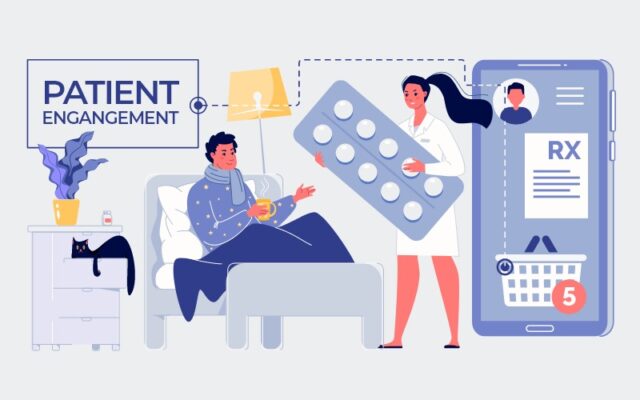Patient engagement has increasingly become a pivotal concept in the healthcare landscape. From a historical perspective, patient engagement has seen a considerable evolution, moving from passive roles towards active participation in the treatment process.
Today, patient engagement lies at the heart of personalized medicine and digital health technologies, promising a future that is more proactive, patient-centric, and responsive to individual health needs.

Historical Perspective
Historically, healthcare was paternalistic, characterized by a unilateral flow of information from physicians to patients. Patients were typically passive recipients of care with little or no involvement in decision-making.
The doctor’s word was law, and patients dutifully adhered to prescribed treatments, often without a full understanding of the underlying medical conditions or the reasons for specific therapies.
Shift toward Shared Decision-Making

In the latter half of the 20th century, this paradigm began to shift towards a model of shared decision-making.
The biomedical model of health, which focused solely on biological factors, gave way to the biopsychosocial model, recognizing the role of psychological and social factors in health and illness.
Patient autonomy was emphasized, and patients began to take more responsibility for their health.
Empowerment through Information Access
The advent of the Internet and the proliferation of health information online accelerated this trend. Patients became more informed, often researching their symptoms, diseases, or treatments before consulting a doctor.
The role of the doctor evolved from the sole authority to a guide or facilitator in the patient’s healthcare journey.
Digital Tools for Enhanced Engagement

This enhanced patient engagement was further facilitated by the emergence of electronic health records (EHRs) and patient portals in the 21st century.
These digital tools allowed patients to access their medical records, schedule appointments, communicate with their healthcare providers, and manage their medications more effectively.
They provided an unprecedented level of transparency and control, empowering patients and promoting active involvement in their healthcare.
The Future of Patient Engagement
Looking forward, the future of patient engagement is promising, driven by advancements in technology and a more holistic understanding of health. One key element is the advent of wearables and other connected health devices.
These technologies enable real-time health monitoring, providing a wealth of data that can be used to tailor treatment and prevent disease. As patients become more familiar with these technologies, they will likely play an even more active role in managing their health.
Telehealth and Virtual Care

Telehealth and virtual care are other critical patient engagement tools shaping the future of patient engagement. The COVID-19 pandemic accelerated the adoption of these technologies, demonstrating their efficacy and convenience.
Going forward, telehealth will likely be integrated into regular healthcare delivery, enabling more flexible, patient-centered care. This approach will be particularly valuable for patients in rural or underserved areas, who often face barriers to accessing healthcare.
Harnessing AI and Machine Learning

Artificial intelligence (AI) and machine learning (ML) also hold immense potential for enhancing patient engagement. These technologies can be used to analyze patient data and provide personalized health recommendations, improving treatment outcomes and potentially predicting health risks.
Moreover, AI-powered chatbots can facilitate patient communication and education, answering queries and providing information in a more accessible, user-friendly format.
Addressing Social Determinants of Health
The concept of patient engagement has also expanded beyond the clinical setting. The idea of social determinants of health – factors like socioeconomic status, education, and neighborhood and physical environment – has gained traction.
In the future, engaging patients might also mean addressing these broader factors, facilitating lifestyle changes, and advocating for health equity.
Challenges and Considerations
However, it’s important to recognize the challenges that lie ahead. Ensuring digital literacy among all demographics, safeguarding patient privacy in an increasingly digital world, and addressing health disparities are just a few hurdles that need to be addressed.
Conclusion
In conclusion, patient engagement has come a long way, shifting from a passive, doctor-driven approach to a more active, patient-centered model.
The future of patient engagement will likely be characterized by increased use of technology, personalized care, and a broader focus on health determinants.
As we navigate this exciting journey, it’s crucial to keep patients at the heart of healthcare, empowering them with the tools, knowledge, and opportunities to actively participate in their health management.
This change necessitates a collaborative effort from all stakeholders – healthcare providers, policymakers, tech innovators, and patients themselves.
The future of patient engagement promises a healthcare system that not only cures diseases but also promotes overall well-being by recognizing the unique needs and preferences of every patient.
As technology continues to evolve and become more integrated into our daily lives, so too will the opportunities for patient engagement.
Embracing this future will require investment in digital literacy training for patients and healthcare professionals, a commitment to privacy and security of health data, and policies that promote access to care for all.
Through these efforts, we can work towards a healthcare system where patients are not merely passive recipients of care, but are active, engaged participants in their health journey.
In the end, the primary goal remains the same: to provide high-quality, person-centered care that improves health outcomes and enhances the patient experience.
A more engaged patient population brings us one step closer to achieving this goal, leading us to a healthier future.
The journey of patient engagement history is a testament to this transformative change, and its future beckons us to embrace an era of proactive, personalized, and participatory medicine.
The history of patient engagement is marked by progress and innovation, and its future is certain to be filled with the same. As we continue to cultivate a culture of engagement, we are not only improving healthcare but also redefining what it means to be a patient.
In the process, we create a future where health is a shared responsibility, a collaborative endeavor that honors the contributions of each person in their healthcare journey.
In essence, patient engagement is more than a trend – it’s a shift in perspective, a new way of understanding health and wellness, and it’s shaping the future of healthcare.









